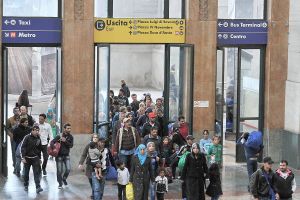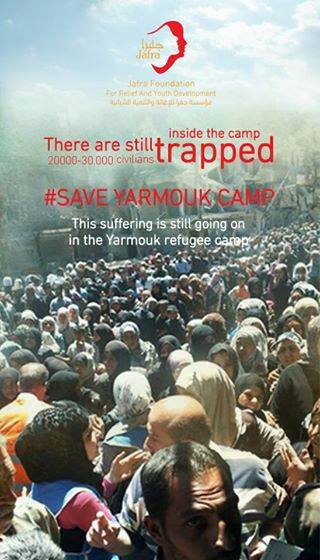
20.000 – 30.000 civils sont toujours pris au piège à l’intérieur du camp.
#SaveYarmoukCamp
Les souffrances continuent sans répit dans le camp de réfugiés de Yarmouk.
Wesam est un jeune palestinien qui milite au sein de “JAFRA”, une organisation communautaire qui aide la population de Yarmouk, en Syrie. Il a très gentillement accepté de répondre à nos questions, pour le public italien, mais pas seulement celui destiné à la Péninsule, puisqu’aussi bien Wesam aurait pu s’exprimer en anglais si son interviewer n’avait pas été arabophone. Cet entretien est la traduction anglaise de la version italienne tirée de l’arabe d’origine. (Interview & traduction italienne de Fouad Rouieha, traduction anglaise de Mary Rizzo, traduction française de Eric Lamy).
Commençons par décrire Yarmouk.
Le camp de réfugiés de Yarmouk est situé au sud de Damas. Il s’étend sur plus de sept kilomètres carrés, juste à côté des districts du centre, tel celui de Midan Zahir. Pour faire court, le camp fait partie du tissu urbain de Damas. Avant le début de la révolte, il comptait 700.000 âmes, dont 220.000 palestiniens d’origine, le reste étant des syriens. Le camp de Yarmouk fut établi en 1957 : la majorité des palestiniens qui y vivent sont des fils de réfugiés de 48, principalement originaires du nord de la Palestine auxquels s’ajoutèrent ceux qui vinrent de Jordanie en 67 et 70. Avant la révolution en Syrie, Yarmouk était une zone économique florissante, considérée comme la capitale de la diaspora palestinienne. Il s’y tenait un marché considérable, le commerce y prospérait. Une véritable ferveur pour les questions sociales et politiques y prévalait, sans oublier ce dynamisme culturel qui faisait de Yarmouk le centre culturel de Damas, le lieu où il se passait quelque chose, où des festivals étaient organisés. Un grand nombre d’artistes célèbres sont originaires de Yarmouk. Pareil à d’autres quartiers, mais plus particulièrement animé, les rues étaient peuplées de boutiques et de restaurants que fréquentaient tous les damascènes. Le weekend, ou pendant les congés, les rues étaient si populeuses qu’on avait du mal à y circuler ; c’était un quartier très peuplé mais également réputé pour la sécurité qu’il offrait.
Vous parlez de l’existence d’un activisme politique, mais être militant, en Syrie, était complètement tabou à cause de la surveillance policière et de la répression toujours possible. Était-ce différent pour les palestiniens ?
J’ai mentionné l’activisme politique en rapport avec la Cause Palestinienne, qui n’avait pas de lien avec la situation syrienne. Yarmouk était une des bases pour les factions palestiniennes : le Front Populaire, le Hamas, le Front Populaire-Commandement Général, le Jihad Islamique, le Fatah… l’activité politique autorisée impliquait le camp de Yarmouk et la Palestine, mais rien qui pût se rapporter directement à la Syrie. Les syriens vivant à l’extérieur du camp assistaient à nos discussions, mais tant qu’il n’était question que de Palestine, tant que la politique syrienne n’était pas évoquée, il n’y avait aucun problème.
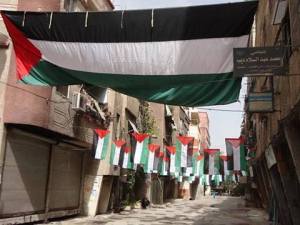
Une rue de Yarmouk.
Parlez-nous de la cohabitation entre syriens et palestiniens-syriens. Peut-on parler d’intégration réussie ou, au contraire, a-t-on assisté à la création d’une sorte de ghetto ?
Entre nous, personne ne faisait de différence. À Yarmouk, nous avons vécu ensemble pendant 50 à 60 ans. Les mariages mixtes sont monnaie courante et nous sommes tous mélangés. Il faut dire que parfois une même famille est partagée entre les deux nations (la Palestine du Nord et la Syrie méridionale n’étant pas séparées à l’époque qui a précédé l’exil palestinien ; des familles et des clans étaient établis de chaque côté de la frontière. Il n’y a pas de différence entre syriens, palestiniens, libanais et jordaniens car des relations d’amitié et de parenté ont toujours existé.
On dit qu’au début de la révolution les palestiniens-syriens du camp ont tenté de se démarquer du conflit.
Non, nous n’avons pas tenté de nous en affranchir : il y a eu un débat considérable pour déterminer si le camp devait s’investir dans la confrontation. Une partie d’entre nous pensait que les militants de Yarmouk qui voulaient se joindre à la révolution devaient s’engager en dehors du camp, sans l’impliquer. Nous savions que si Yarmouk était visé par des représailles, elles seraient extrêmement violentes : c’est malheureusement ce qui est arrivé. Ensuite, l’idée à circulé selon laquelle Yarmouk pourrait être un lieu de repli sûr pour les syriens déplacés, pour les blessés, afin de leur permettre d’accéder aux soins médicaux et au ravitaillement. Au cours des deux premières années, Yarmouk à rempli ce rôle. Quand les affrontements ont éclaté dans les zones de Al Hajar Aswad ou de Tadamon, Yarmouk était un centre de distribution de produits médicaux et d’entraide. Nous accueillions les réfugiés. Avant eux, nous avions déjà recueilli les réfugiés de Homs : il y avait là tant de familles ! Pour eux, nous avons ouverts des refuges, profitant des écoles de l’UNRWA (agence de Nations Unies pour les Réfugiés Palestiniens, n.d.l.t.) et de celles de l’état. C’était des refuges protégés pour ces gens où ils furent accueillis, nourris et logés. Lorsque le Commandement Général à incité certains d’entre nous à prendre les armes contre l’Armée Syrienne Libre, Yarmouk a été directement impliqué dans les combats : l’ASL est entrée dans le camp et il devint, comme les autres districts de Damas, la cible du régime syrien.
On nous a rapporté des abus commis par l’ASL…
Ceux qui sont entrés dans Yarmouk n’étaient pas tous de même obédience : il y avait là des tas de gens différents et, parmi eux, des criminels de droit commun déguisés en révolutionnaires, comme cette “Brigade des Fils du Golan” qui était, en fait, un gang de kidnappeurs et de voyous. Ils ont incendié des maisons et en ont pillé d’autres. Cela a duré 6 mois, puis l’ASL, constituée de palestiniens et de syriens, les à délogés du camp.
Concernant la révolution syrienne, qu’elle est la position des factions palestiniennes à l’intérieur du camp ?
Elle est contradictoire : d’un côté, les partisans du FPLP-GC, du Fatah Al Intifada qui combattaient aux côtés des loyalistes. Les proches du Hamas ainsi que des groupes indépendants se battaient contre le régime. La division qui existe dans la population syrienne est la même qui affecte la société syro-palestinienne.
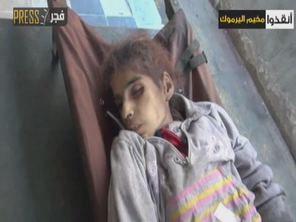
Une victime de la famine.
Pouvez-vous chiffrer la population vivant à l’intérieur du camp ?
Nos données diffèrent de celles de l’UNRWA : nous sommes sur une base de 25 à 30.000 personnes, dont 5000 syriens, le reste des résidents étant palestiniens. Ceux qui sont restés n’ont nulle part où aller et il n’y a plus de place dans les refuges. Pauvres d’entre les pauvres, ces palestiniens et ces syriens n’ont pas d’argent pour louer une maison et ils n’ont pu trouver de place dans les dispensaires du camp. Certains d’entre eux ont pu, un temps, s’installer dans les différents jardins publics de Damas, mais ils en sont revenus. Il y a aussi ceux qui n’ont pu fuir de peur que leur fils soit enrôlé de force dans l’armée. Il y a là des gens qui n’ont pas de papiers, pas de carte d’identité et ne peuvent donc pas sortir du camp. Soyons un peu logiques : il y a 30.000 civils à Yarmouk. S’ils avaient vraiment été des combattants, Damas serait tombée en 2 jours ! Parmi les hommes en armes à l’intérieur du camp, on compte environ 1000 palestiniens et 500 syriens : voilà tous les combattants du camp. Ces palestiniens sont natifs de Yarmouk. Ils ont formé des comités de dėfense, pas seulement contre le régime mais pour des raisons de sécurité interne : les institutions ont volė en éclat, l’anarchie est partout. Il fallait protéger les résidents des voleurs, des kidnappeurs. Ces comités de défense remplissent, en fait, une fonction de police. Il leur arrive même de régler des problèmes familiaux.
Aujourd’hui, comment décririez-vous la situation humanitaire ?
Yarmouk vit sous siège partiel depuis décembre 2012. Cela signifie que les civils peuvent entrer et sortir avec ce qu’ils peuvent transporter. Bien sûr, les camions chargés de nourriture sont interdits. Depuis le début du siège, nous n’avons réussi qu’à faire entrer 4 camions, ce qui a entraîné l’arrestation de quelques volontaires et la mort de Khaled Bakrawi. En juin 2013, le siège à été complètement fermé : plus personne ne put entrer ou sortir, plus de nourriture, plus de produits médicaux, plus aucun bien de consommation ne furent autorisés à pénétrer à l’intérieur du camp. Au bout de 4 mois sont apparus des cas extrêmes de malnutrition et les gens ont commencé à mourir. À ce jour, nous avons répertorié 154 cas de décès dûs à la faim, sans parler des cas où la faim n’est qu’un facteur du de la mort. La nourriture continue de manquer ; il y a bien eu des tentatives diplomatiques ces deux derniers mois qui n’ont abouti qu’à la livraison de 12000 paniers-repas qui ne permettent chacun que d’assurer la subsistance d’une famille de 4 personnes pendant 10 jours. Quiconque en a reçu un n’a plus rien aujourd’hui. Plus tard, 5000 paniers contenant de la confiture, des dattes et un peu de pain furent distribués. Cette dernière livraison fut assurée par l’UNRWA, tandis que nous avons réussi à en distribuer entre 4 à 5000.
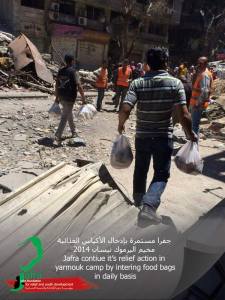
Des volontaires de JAFRA distribuent des sacs de nourriture.
La situation médicale et sanitaire : il n’y avait qu’un seul hôpital en activité à Yarmouk, l’Hôpital de Palestine, qui a été fermé par suite du manque de carburant (“mazot”, une sorte de fioul utilisé pour les groupes électrogènes et les stérilisateurs, ndlt). Comme l’électricité a été coupée dans le camp il y a treize mois, l’hôpital ne peut plus compter que sur les générateurs. Il n’y a plus de produits médicaux dans le camp et le seul médecin présent à Yarmouk a été tué il y a 6 mois, comme il sortait de l’hôpital, au cours d’un bombardement. Le personnel médical ne se compose plus que d’infirmières ; leur travail est guidé par l’expérience, mais ils ne sont ni médecins, ni spécialistes. Le mois dernier, nous avons pu exfiltrer 400 cas graves hors du camp. Au cours de l’évacuation, certains ont pourtant été arrêtés par les forces de sécurité du régime. À ce jour, nous avons des cas de malades qui réclament leur évacuation, mais il est absolument impossible aux civils de quitter le camp.
Parlez-nous de la vie quotidienne d’un résident de Yarmouk. J’imagine qu’il est peu probable qu’il puisse y travailler ?
Il n’y a plus de travail à l’intérieur du camp. Les routes sont fermées : pas de déplacement, pas de commerce possible. Le problème majeur est le prix élevé de la nourriture, car la contrebande de denrées est apparue. Il y a un mois et demi, un kilo de riz coûtait environ 12.000 livres syriennes (LS), l’équivalent d’à peu près 70$. Le tarif a baissé légèrement le mois dernier, mais il faut se dire qu’il coûtait 1$ voici trois ans, qu’il coûte 1$ dans les zones qui entourent le camp, soit soixante-dix fois moins ! Un litre de fioul pour groupe électrogène revient à environ 600/700 LS et coûte seulement 100 LS dans Damas. De toutes façons, il n’en reste presque plus à l’intérieur du camp. Certaines ONG – dont notre Fondation JAFRA – ont mis en place des projets agricoles d’auto-suffisance à l’intérieur du camp. Cela n’a pas trop bien marché l’hiver dernier à causes du temps, mais cela va beaucoup mieux. Il y a ceux qui ramassent de l’herbe dans les prés, et nous avons recensé 5 morts dûs aux snipers du régime qui surveillent ces prés. Les autres se contentent d’exister à l’intérieur de Yarmouk, fouillent les maisons abandonnées à la recherche de nourriture, une poignée de riz ou de farine, quelques épices, n’importe quoi qui puisse se manger. Voilà comment vivent ces gens…
Au cours des mois écoulés, lors de tentatives d’introduire des convois d’aide humanitaire, des attaques ont eu lieu : le régime en a rejeté la responsabilité sur les rebelles.
Il ne s’agissait pas d’attaques directes, bien qu’il y ait eu des tirs dont nous n’avons pas pu établir l’origine. Les deux parties s’accusent mutuellement. La milice accuse le Commandement Général, et celui-ci dénonce les islamistes armés. En réalité, des tirs de la milice ont empêché la distribution mais, franchement, je ne pense pas que l’intention était délibérée. Ils souffrent du siège comme les autres et sont logés à la même enseigne. Je crois plutôt qu’au cours d’un engagement avec les forces loyalistes les convois ont été pris entre deux feux.
Pour finir, avez-vous un message à faire passer à la société italienne ?
Il y a à peu près 30.000 personnes dans le camp de Yarmouk, dont 1200 enfants. Beaucoup sont nés pendant le siège. J’y étais il y a trois mois : ces enfants ne savent plus le goût de la nourriture. L’un d’entre eux rêve de déguster une simple pomme de terre, de manger quelque chose de bon, quelque chose de sucré. Des personnes âgées ont besoin de remèdes pour leur tension artérielle, leurs problèmes cardiaques, leur diabète, tous les traitements simples et basiques dont le manque total cause leur décès. Les blessés sont contraints à l’amputation par faute de simple traitement. Pas de médicament, pas de médecin ! Nous avons besoin de vaccins pour nos enfants. Les problèmes sont immenses : ils n’ont plus la moindre idée de ce qu’est une vie normale et n’imaginent même plus comment est-ce en dehors du camp. Quelle faute ont donc commis ces enfants et ces civils pour souffrir autant ? Ce qui se passe à Yarmouk est contraire à tout principe d’humanité, contraire à toute notion de patrie, contraire à toute idée de panarabisme, toutes choses pour lesquelles le régime syrien se targue d’être en première ligne !
English: http://radiofreesyria1.wordpress.com/2014/05/06/extreme-suffering-in-yarmouk-camp-interview-with-wesam-sabaaneh/
